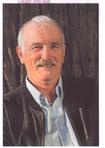John Michael McCarty's Blog
May 3, 2019
Villa Grande
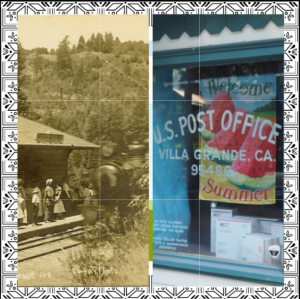
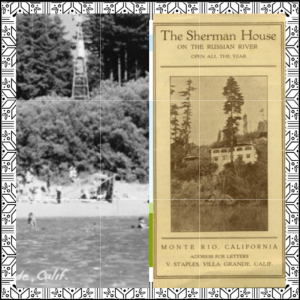
Villa Grande is an unincorporated community in Monte Rio along the Russian River. How the name Villa Grande was born is a story unto itself. In the very beginning, there was “Big Flat”, a patch of land filled with redwoods and owned by the Northwestern Pacific Railroad, which ran along present-day Moscow Road. The logging boom started to fizzle out by the beginning of the twentieth century, causing NWPR to sell lots in the Big Flat area. A fourth-class post office was established under the title of “Mesa Grande”, a name which adorned the train depot as well (far left photo). Unfortunately, there was another Mesa Grande located in the San Diego area, necessitating a change. The post office operated under the new moniker of “Grandville”, doing business out of a cubbyhole in the general store. However, due to confusion with Grandeville in Tulare County, there was yet another adjustment. With a bit of linguistic trickery, “Grandville” was turned inside out to become “Villa Grande” and has remained such since 1921.
Sidebar: In 1973, the post office (near left photo) was moved to the garage/workshop area of the general store owner’s private residence in order to create a private lobby and additional mailboxes. It has remained at this site ever since.
Vacationers from San Francisco would climb aboard the North Pacific Coast Railroad for the three-hour ride from Sausalito to their front door in Villa Grande. The community soon accommodated a hotel, firehouse, general store, post office, and numerous shingled cottages. 1910 was the first year that electricity arrived along with a windmill (near right photo), which supplied water to the cabins. It was dismantled in 1977 and given to a camp in Cazadero but the attached house still remains. With the revenue collected from their whist games, the good ladies of the village erected a sturdy windbreaker for the main beach each summer, which was located directly in front of the windmill. Across the river was the Sherman House (known today as “The Chocolate House”…far right photo), which served as a hotel for those visiting Monte Cristo. This tourist locale extended from the Sherman House to present-day Monte Cristo Avenue near the Monte Rio Elementary School. This was the most popular party venue for residents of Villa Grande as it rightly laid claim to hosting the largest dance floor along the lower reaches of the Russian River
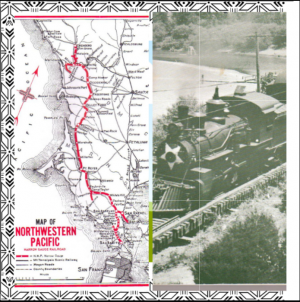
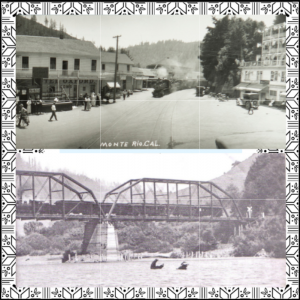
It appears that the Russian River resorts reached a tipping point in the summer of 1910 when there was a jump in the number of visitors. It was the first season after the Northwestern Pacific (NWP) line finally joined with the narrow gauge railway coming up the coast. This meant someone in San Francisco could easily reach the popular resorts on the west end of the Russian River. No longer was it necessary to board the San Francisco and North Pacific Railroad (SFNP) to Fulton near Santa Rosa and transfer to a slooooow connection that crawled as it made over a dozen stops along the way including Dell, Hilton, Eagle Nest, Guerneville, Montesano, and Camp Vacation near today’s Northwood. For a long time, this was the end of the line.
The coast route (far left photo) took you through Fairfax, Tomales Bay, Valley Ford, Freestone, Occidental, Camp Meeker and onto Monte Rio where it continued down today’s Moscow Road (near left photo). From there it stopped at Mesa Grande (Villa Grande) before going onto Duncans Mills and beyond.
Sidebar: This coastal trip was quite the adventure, rumbling through five different tunnels and over sixty-nine trestles. Two engines could pull as many as thirteen cars including open-end platform types, enclosed passenger coaches, smokers’ car, baggage and mail, second-class couches, picnic and hunters’ cars, students’ car, and a caboose.
On December 20, 1920 the Northwestern Pacific Railroad experienced its worse mishap in rural Sonoma County. After leaving the station in Monte Rio (upper right photo) and before crossing the bridge to Duncans Mills (lower right photo), engine No. 222 encountered a slide that buried the tracks near Mesa Grande (Villa Grande). No sooner would a steam shovel remove the debris when another load of muck took its place. A large locomotive, which could furnish 200 pounds of steam pressure, made its way up from Tiburon with a hydraulic pump. Even though the engine proceeded at 10 m.p.h., its weight broke fifteen rails along the way.
Upon arriving at the scene, the cleanup endeavor went smoothly until January 9, 1921 when another slide tipped the engine over and partly buried it along with the operator. Only one of his legs stuck out from the slime. Rescue efforts were unsuccessful. The operator suffocated to death while another lost his hand in the recovery attempt. It was decided to let the slide sit until spring. In the meantime, passengers would disembark, walk around the work zone and board a second train to resume their trip.
Sidebar: Railroad operations continued in the ensuing years peaking in 1923 when the July 4th weekend saw some thirty thousand persons boarding ferry boats from San Francisco’s Embarcadero to the train terminal in Sausalito for the ride to the Russian River.
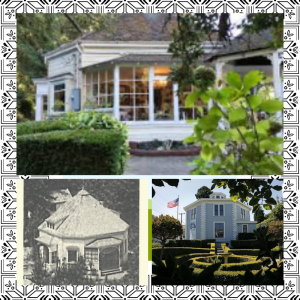
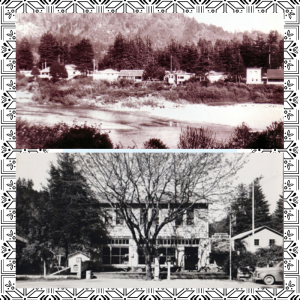
After the logging had been exhausted in Mesa Grande (Villa Grande), the North Pacific Coast Railroad formed a subsidiary, the North Shore Land Company, to develop its properties. There was a lumberyard located here with half of its full-time residents working in construction. Riverfront lots were sold at seventy-five dollars each and the remainder at fifty. Wood shingles beautified the exterior while burlap lined the inside walls.< p/>
Built in 1905, the Lois Cottage at 21866 East St. (upper left photo) is typical of the early homes in Mesa Grande, costing roughly $200. Lois Tidball lived there while engaged to Captain Nelson, who sailed out of San Francisco. Legend states that the Captain took Lois and her daughter (from a previous marriage) on his ship for one last voyage and returned married to his fiance’s daughter. Captain Nelson supposedly buried valuables from his worldly travels on the River property for his bride’s financial security.
Present-day owners of Lois Cottage, Rich and Wanda Holmer, hired professional treasure hunters to explore the area with metal detectors, but no precious trove has been discovered at the time of this writing. Perhaps Lois Tidball had her revenge and lifted the booty from under her unfaithful lover’s eyes. Or perhaps the mother and daughter had schemed such an outcome all along. Oh, the drama!
Another example of a Craftsman cottage in Villa Grande is at 21894 Russian River Ave. (lower left photo), built in 1933. It features 1100 sq. ft., two bedrooms, two baths and recently sold for $1.1 million. How things have changed.
Sidebar:In those early days the lone phone in the hamlet resided at the General Store. Its number was 15-R.
Most of the activity in Villa Grande (upper right photo) during the 1950s centered around the General Store and the old hotel. It was a real treat for kids to gather some spare change after a barbecue dinner and head down to the store ( lower right photo) where they would load up on hard candy, root beer barrels, candy grab bags and RC Colas. Warren Payne recalls his failing ritual of purchasing a toy balsa wood airplane only to invariably lose it to the limbs of a nearby redwood. The post office was located here as well where a myna bird and a dog named Laddie would great patrons upon entering.
Since few homes had full kitchens back then, members of the community often took their meals at the old Villa Grande Hotel, which was built around 1920. In addition to the main building, ten tent-cabins on wooden platforms were built for summer visitors. Hearty Italian fares as well as delicate pastries awaited consumption.
Sidebar: The hotel at 21849 East St. was razed and replaced by a private residence.

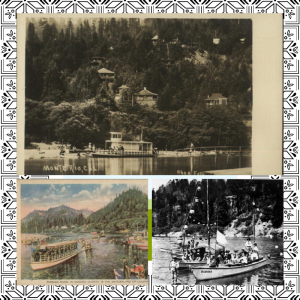
San Francisco architect McLachlan built the Octagon House (upper left photo) that presently sits at 22292 Moscow Rd. near Villa Grande. Horticulturist John McClaren, a crony of McLachlan’s and best known as the man who created Golden Gate Park, designed the gardens. The McLachlans used the house as a summer getaway for approximately thirty-five years, hosting parties for their friends traveling from the City for galas along the Russian River. Sailing was always a popular amusement for guests and a boathouse was located on the property.
McLachlan designed a similar structure, the McElroy House on Gough Street in San Francisco, now a national historic site (lower left photo). The building is a bit of a time capsule of the city itself when Cow Hollow was way out in the country. It was on the cutting edge of innovation in 1861, even without indoor plumbing or a kitchen.
John King built a small stern-wheel steamboat in 1869 and sailed it along the Russian River. Named the Enterprise, there are no known photos of the vessel but it probably resembled the Montrio (upper right photo). King’s little ship was fifty feet long and sat high in the water, with a draft of only a foot, perfect for the shallow stream. He carried cargo from Heald and Guern Lumber Mill (near Guerneville’s Safeway today) to the mouth of the river at Jenner. On occasion he would promote excursions, towing two barges upon which revelers would dance to live music while under steam. After several failed attempts, the Enterprise sunk trying to reach Healdsburg.
Before the railroad line was extended west from Northwood, passengers would have to disembark and board the Sonoma (lower colored right photo), which would transport them downstream to connect with the North Pacific Coast R.R. in Monte Rio.
Small sailing skiffs were popular in the early days. The ones pictured on the extreme lower right were believed to belong to architect McLachlan of San Francisco who built a boathouse for his toys on the banks of his Octagon House.
Sidebar: When the dams go up in the summer, you can still witness a sailboat or two tacking through the wind between Guerneville and Vacation Beach to the west. With the right mixture of stupidity and liquid fortification, party animals can be seen on the back end of a ski rope as well.
The post Villa Grande appeared first on John McCarty.
April 2, 2019
Sailing on the Russian River
 John King built a small stern-wheel steamboat in 1869 and sailed it along the Russian River. Named the Enterprise, there are no known photos of the vessel but it probably resembled the Montrio (upper photo), which plied the waters as far west as the old Monte Rio footbridge. King’s little ship was fifty feet long and sat high in the water, with a draft of only a foot, perfect for the shallow stream. He carried cargo from Heald and Guern Lumber Mill (near Guerneville’s Safeway today) to the mouth of the river at Jenner. On occasion he would promote excursions, towing two barges upon which revelers would dance to live music while under steam. After several failed attempts, the Enterprise sunk trying to reach Healdsburg.
John King built a small stern-wheel steamboat in 1869 and sailed it along the Russian River. Named the Enterprise, there are no known photos of the vessel but it probably resembled the Montrio (upper photo), which plied the waters as far west as the old Monte Rio footbridge. King’s little ship was fifty feet long and sat high in the water, with a draft of only a foot, perfect for the shallow stream. He carried cargo from Heald and Guern Lumber Mill (near Guerneville’s Safeway today) to the mouth of the river at Jenner. On occasion he would promote excursions, towing two barges upon which revelers would dance to live music while under steam. After several failed attempts, the Enterprise sunk trying to reach Healdsburg.
Boating:
Before the railroad line was extended west from Northwood to Monte Rio and beyond, passengers would have to disembark and board the Sonoma (lower left photo), which would transport them downstream to connect with the North Pacific Coast R.R. Small sailing skiffs were popular in the early days. The ones pictured on the lower right were believed to belong to architect McLachlan of San Francisco who built a boathouse for his toys on the banks of his Octagon House along today’s Moscow Road near Villa Grande.
When the dams go up in the summer, you can still witness a sailboat or two tacking through the wind between Guerneville and Vacation Beach. With the right mixture of stupidity and liquid fortification, party animals can be seen on the back end of a ski rope as well.
The post Sailing on the Russian River appeared first on John McCarty.
March 28, 2019
Octagon House
Well-to-do San Francisco architect McLachlan built the Octagon House that presently sits at 22292 Moscow Rd. near Villa Grande. Horticulturist John McClaren, a crony of McLachlan’s and best known as the man who created Golden Gate Park, designed the gardens. The McLachlans used the house as a summer getaway for approximately thirty-five years, hosting parties for their friends traveling from San Francisco for galas on the Russian River. Sailing was always a popular amusement for guests and a boathouse was located on the property. The residence is used today for weddings and other assorted gaieties.
Octagon House:
McLachlan designed a similar structure, the McElroy House on Gough Street in San Francisco, now a national historic site. The building is a bit of a time capsule of the city itself when Cow Hollow was way out in the country. It was on the cutting edge of innovation in 1861, even without indoor plumbing or a kitchen.
The post Octagon House appeared first on John McCarty.
March 25, 2019
Villa Grande Summers
 Most of the activity in Villa Grande (upper photo) centered around the General Store and the old hotel. It was a real treat for kids to gather some spare change after a barbecue dinner and head down to the General Store (lower photo) where they would load up on hard candy, root beer barrels, candy grab bags and RC Colas. Warren Payne recalls his failing ritual of purchasing a toy balsa wood airplane only to invariably lose it to the limbs of a nearby redwood. The post office was located here as well where a mynah bird and a dog named Laddie would great patrons upon entering.
Most of the activity in Villa Grande (upper photo) centered around the General Store and the old hotel. It was a real treat for kids to gather some spare change after a barbecue dinner and head down to the General Store (lower photo) where they would load up on hard candy, root beer barrels, candy grab bags and RC Colas. Warren Payne recalls his failing ritual of purchasing a toy balsa wood airplane only to invariably lose it to the limbs of a nearby redwood. The post office was located here as well where a mynah bird and a dog named Laddie would great patrons upon entering.
Summertime:
Many of the homes in Villa Grande are Craftsman style originals, built for summertime use only. Since few homes had full kitchens back then, members of the community often took their meals at the old Villa Grande Hotel, which was built around 1920. In addition to the main building, ten tent-cabins on wooden platforms were built for summer visitors. Hearty Italian fares as well as delicate pastries awaited consumption. The hotel was razed and replaced by a private residence at 21849 East St.
The post Villa Grande Summers appeared first on John McCarty.
March 10, 2019
Flood Hits Hard
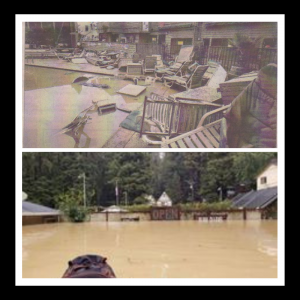 The flood last week was Jeff Bridges’ fourth rodeo. He is the owner of the R3 Hotel in Guerneville. Over eight feet invaded his lodge, bar and restaurant (upper photo). But Bridges was not intimidated. After all, he had had his tetanus shot and was prepared to use lots of bleach and power washers. However, even with protective gear, it is difficult to keep the river crud at bay. It splashes onto your face and other areas of exposed skin. Some were forced to halt cleanup as sickness set in, diarrhea in full swing.
The flood last week was Jeff Bridges’ fourth rodeo. He is the owner of the R3 Hotel in Guerneville. Over eight feet invaded his lodge, bar and restaurant (upper photo). But Bridges was not intimidated. After all, he had had his tetanus shot and was prepared to use lots of bleach and power washers. However, even with protective gear, it is difficult to keep the river crud at bay. It splashes onto your face and other areas of exposed skin. Some were forced to halt cleanup as sickness set in, diarrhea in full swing.
“It will be a total gut job and renovation,” Bridges said. “But it will reopen bigger, better and more sparkly than before.” Such is the uplifting attitude and familiar refrain from many who are determined to thumb their nose at the rebellious Russian River in exchange for a slice of paradise.
2019 Flood Damages:
Raena and Brad Metzger watched from nearby as floodwaters rose toward the eaves of their Rio Nido Roadhouse bar and restaurant (lower photo). They had sunk their life savings into the business, which could not withstand the slow moving disaster that swallowed the building. “I would not wish this on anyone,” Brad said. And he is not alone. There are over 3,500 structures in flood zones county wide, including nearly 2,500 homes and 438 commercial or industrial buildings. Several residences in Guerneville and Monte Rio have been red-tagged or yellow-tagged and will have to pay the $600 permit fee by the county to fix what must be fixed. Some complain that the flood is a money-maker for the Permit & Resource Management Department.
The post Flood Hits Hard appeared first on John McCarty.
Businesses Flooded
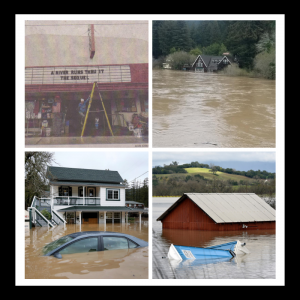 The February 27th flood injured several businesses along the Russian River, including over four hundred commercial or industrial buildings countywide. The Rio theater in Monte Rio (upper left photo) had seen this several times before, at least seven times since its construction in 1950, but not to worry. Its iconic piece of Christo’s Running Fence rests high and dry across the theater’s ceiling. The owner, like many hardy souls in the area, owns a sense of humor. Last weekend he changed the marquee out front to read A River Runs Thru It.
The February 27th flood injured several businesses along the Russian River, including over four hundred commercial or industrial buildings countywide. The Rio theater in Monte Rio (upper left photo) had seen this several times before, at least seven times since its construction in 1950, but not to worry. Its iconic piece of Christo’s Running Fence rests high and dry across the theater’s ceiling. The owner, like many hardy souls in the area, owns a sense of humor. Last weekend he changed the marquee out front to read A River Runs Thru It.
God only knows how many times the Highland Dell Hotel in Monte Rio (upper right photo) has been inundated since its inception in 1910. Records state nine such incidents have occurred, but there have been several times when rain gauges have been swept away or damaged beyond useful. Its beautiful lobby, bar, and dining area are under three feet of water. We wish Herb and Ingrid a quick recovery.
Businesses on the Fritz:
D & G Equity Management (lower left photo) saw their lower offices receive water. Furniture, electrical appliances, etc were destroyed. Sheetrock and flooring will have to be replaced. The structure sits in a low-lying area on Mills Street in Guerneville between the post office and the Timberline at Bucks restaurant. As the waters receded, business owners and residents on those back streets were able to clean up. A solid wall of debris, six feet high, runs for several blocks, waiting for the help that may never come. Federal and state emergency funds are strapped due in large part to past fires. Money will not be coming to the county from these outside sources for curbside pickup with the exception of toxic fluids. In the meantime, health concerns mount.
Grape vines are hardy but may have difficulty withstanding the effects of repeated flooding. The vineyards in Forestville (lower right photo) are typical and may be forced to follow the path taken by Korbel Winery, which had to remove several acres of grapes near the Russian River.
The post Businesses Flooded appeared first on John McCarty.
March 9, 2019
2019 Russian River Flood
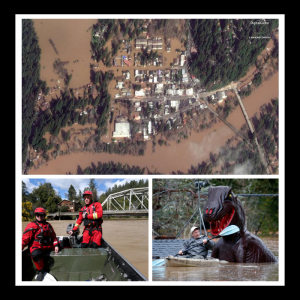 Major flooding along the Russian River in Sonoma County on Wednesday, February 27, 2019 prompted mandatory evacuations and left two towns accessible only by boat (see aerial photo of Guerneville). The river crested at 45.4 feet, the sixth largest flood in the area since recording such events began in 1879. At 33 feet the river crept onto the peewee golf course in Guerneville (lower right photo) and the Mirabel trailer park in Forestville. No big deal. At 39 feet River Road began to close near Hacienda Bridge (lower left photo-rescue workers motor near bridge) and the Triple R Resort in Guerneville flooded. Hmmmm.
Major flooding along the Russian River in Sonoma County on Wednesday, February 27, 2019 prompted mandatory evacuations and left two towns accessible only by boat (see aerial photo of Guerneville). The river crested at 45.4 feet, the sixth largest flood in the area since recording such events began in 1879. At 33 feet the river crept onto the peewee golf course in Guerneville (lower right photo) and the Mirabel trailer park in Forestville. No big deal. At 39 feet River Road began to close near Hacienda Bridge (lower left photo-rescue workers motor near bridge) and the Triple R Resort in Guerneville flooded. Hmmmm.
At 41.5 feet, True Value hardware, Napa Auto Parts and Stumptown Brewery along the strip between Guerneville and Rio Nido had already accumulated over a foot of water.
2019 Flood:
River Road closed, Main Street in Monte Rio closed and a major mudslide occurred near the skatepark blocking escape to Occidental. Austin Creek Road closed to Cazadero, which experienced nineteen inches of rain in thirty hours. Towns became islands. Uh oh.
At 45.4 feet (nearly 14 feet above flood stage) Bartlett’s market in Monte Rio took on water; parts of four golf holes at Northwood went under. Over 3,500 people were under evacuation orders while approximately 2,000 homes and businesses were damaged, the Associated Press reported. Two wastewater treatment plants were not working, leading to concerns of contaminated spillage. In downtown Guerneville, some residents stood on the roofs of their flooded two-story houses, watching neighbors and others paddling kayaks down watery streets. Oversized National Guard trucks occasionally sloshed by, creating waves, which exacerbated the issue in some cases.
The post 2019 Russian River Flood appeared first on John McCarty.
March 8, 2019
New Year’s Eve Flood, 2005
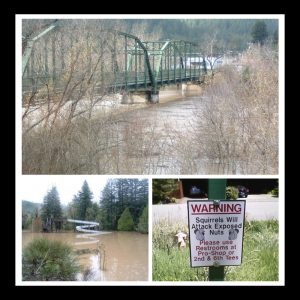 The New Year’s Eve flood of 2005 crested at 41.8′ at the pedestrian bridge in Guerneville (upper photo). The abandoned amusement park (across highway 116 from the peewee golf course) renders new meaning to the term “water slide” (lower left photo).
The New Year’s Eve flood of 2005 crested at 41.8′ at the pedestrian bridge in Guerneville (upper photo). The abandoned amusement park (across highway 116 from the peewee golf course) renders new meaning to the term “water slide” (lower left photo).
At the Northwood Golf Course in Monte Rio, a sign warns visitors what will happen if they do not use the “proper” facility (lower right photo). Perhaps a certain New Year’s Eve reveler should have taken this as an omen. A visitor to the area, he had rented both a vehicle and a house to celebrate the incoming of 2006. But heavy rains blocked Redwood Drive, which ran to the lower reaches of the course. Wanting desperately to feel the warmth of his cabin after an arduous night of bar hopping, the man motored past the second tee box, around the restrooms and started down the cart path, cruising parallel to the fifth fairway.
Flood of 2005-2006:
The stranger reached a steep slope facing the fifth tee box. Not familiar with the terrain, he eased the nose of the burgandy Mustang downward. The current reached the engine compartment. The inebriated soul attempted to reverse to safety but to no avail. Stuck, he abandoned the vehicle and waded thru the waters to his “vacation” house. To counter eyewitness stories that he was driving under the influence on New Year’s Eve, he lied to the police a few days later and said instead that he was driving during the afternoon on January 1st when he got stuck. Unbeknownst to him, the car rental agency had changed its policy for 2006, not allocating any towing fees. Outsmarted by himself, the stranger forked up a couple of Franklins and went on his way, not so merrily I might add.
The post New Year’s Eve Flood, 2005 appeared first on John McCarty.
March 7, 2019
Monte Rio, 1986 Flood
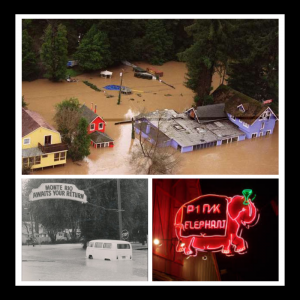 In Monte Rio, the flood of February 18, 1986 reached 48.56 feet, inundating much of the town. The upper photo depicts the old Highland Dell resort alongside private residences, taking on as much as eight feet of water. In the lower left photo is pictured a classic. VW buses are great for a number of things—camping, hitchhiking, parking at inspiration point—but fording through water, not so much. You wonder if the driver will get help, or even contemplate returning as the sign above suggests?
In Monte Rio, the flood of February 18, 1986 reached 48.56 feet, inundating much of the town. The upper photo depicts the old Highland Dell resort alongside private residences, taking on as much as eight feet of water. In the lower left photo is pictured a classic. VW buses are great for a number of things—camping, hitchhiking, parking at inspiration point—but fording through water, not so much. You wonder if the driver will get help, or even contemplate returning as the sign above suggests?
The torrent brought both sadness and humor to the scene. One story relates how the Pink Elephant saloon in Monte Rio kept its doors open despite the presence of three feet of muddy water. Patrons continued to play a game of pool while in their canoes. Others sipped whiskies, feet dangling from bar stools into the river as if it was just another day in paradise.
Flood of ’86:
The bartender locked up and began walking through the flooded street to his home. However, somewhere along his journey he lost his way and fell into the raging waters and drowned. The family of the deceased complained to the folks at the Guerneville Redwood Chapel when their relative appeared in his coffin without his favorite leather jacket as requested. The mortician’s assistant said that the victim arrived from the local authorities without any such apparel. Soon thereafter inside the town’s Safeway, a member of the deceased’s family spotted the son of the mortuary’s owner wearing the leather jacket. A struggle ensued and the treasured item was removed from the interloper and returned to its proper owner.
The post Monte Rio, 1986 Flood appeared first on John McCarty.
March 6, 2019
1986 Russian River Flood
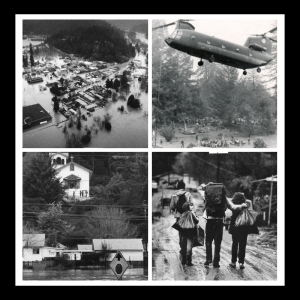 A wet El Nino swept in a series of tropical storms, beginning February 13, 1986 leading into a three-day weekend capped by Valentine’s Day and Presidents’ Day. Two years earlier, workers had completed Warm Springs Dam, which held back the flows of Dry Creek, and created Lake Sonoma. Officials said it spared downstream residents what would have been an additional five vertical feet of flooding. But some say that premature releases from the dam increased the water levels (upper left photo).
A wet El Nino swept in a series of tropical storms, beginning February 13, 1986 leading into a three-day weekend capped by Valentine’s Day and Presidents’ Day. Two years earlier, workers had completed Warm Springs Dam, which held back the flows of Dry Creek, and created Lake Sonoma. Officials said it spared downstream residents what would have been an additional five vertical feet of flooding. But some say that premature releases from the dam increased the water levels (upper left photo).
Evacuees were offered temporary shelter at the Veterans Memorial Building in downtown Guerneville, though it was abandoned when water crept too close. The shelter was then moved to St. Hubert’s Hall off Armstrong Woods Road and then to a higher elevation, St. Elizabeth’s Catholic Church.
1986 Flood:
In the ensuing days, small groups would leave for the cemetery above the church where they would be airlifted by helicopter to Santa Rosa (upper right photo).
Further west, in Monte Rio several diehards waited out the storm. “Let me tell you, it was creepy to hear your house groan because of the current that’s going through it,” said Tony Moscarelli. “There was a freezer down in the basement, and it was bashing into the walls down there. That was a really creepy feeling.”
Approximately 500 other people had spent nights huddled inside St. Catherine’s Church high above the flood (lower left photo). A few days later people started to return home, not knowing what awaited them (lower right photo). Many lost everything. Several residents were told that the controversial Warm Springs Dam project would prevent deluges and, therefore, did not renew their flood insurance in advance.
The post 1986 Russian River Flood appeared first on John McCarty.

